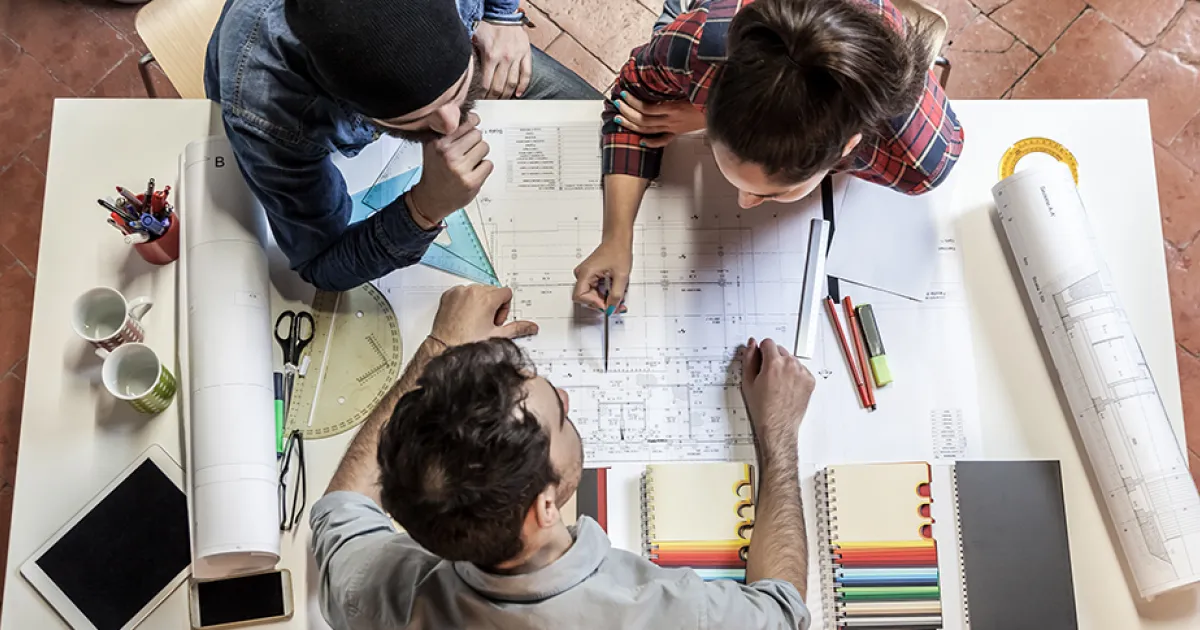Architect Hiring Guide for Homeowners and Developers
Architect Hiring Guide for Homeowners and Developers
Blog Article
Comprehending the Diverse Job Paths Available for Aspiring Architect
As a hopeful Architect, you have a globe of occupation paths waiting for you. Whether you're attracted to conventional design or the subtleties of lasting layout, there's a particular niche that lines up with your passions.
Standard Design: Creating Structures and Frameworks
Conventional design focuses on creating structures and structures that mix performance with aesthetic charm. Your layouts can reflect social heritage, showcasing regional practices while satisfying modern needs.
You'll create abilities in preparing, model-making, and site analysis, allowing you to imagine and interact your ideas successfully. Involving with clients, you'll need to understand their vision and equate it into feasible styles.
In addition, building codes and sustainability methods are necessary in your work, ensuring your structures are secure and eco-friendly. As you expand in your career, you'll discover possibilities in residential, commercial, and even reconstruction tasks, each offering unique obstacles. Accepting standard style leads the method for a fulfilling occupation that pays tribute to the past while shaping the future.
Urban Planning: Forming Areas and Public Spaces
As a hopeful Architect, you can play a vital duty as a metropolitan coordinator, changing exactly how neighborhoods operate and connect. By employing neighborhood involvement techniques, you'll guarantee that homeowners have a voice in forming their setting. And also, incorporating sustainable layout concepts will certainly help develop spaces that not only fulfill today's needs however also safeguard the future.
Function of Urban Planners
While several could believe of architects as the sole visionaries behind buildings, urban planners play an essential duty in shaping the wider landscape of areas and public spaces. By teaming up with various stakeholders, you'll help develop parks, transport systems, and domestic areas that promote social interaction and accessibility. Your competence in spatial style and area characteristics allows you to imagine future growth while maintaining cultural heritage.
Neighborhood Engagement Techniques
Efficient area involvement techniques are essential for city organizers to assure that the voices of homeowners are listened to and valued in the preparation process. To promote purposeful dialogue, you ought to prioritize open forums and workshops where community members can share their concepts and concerns. Use surveys and social networks to reach a wider audience, making certain varied point of views are included. Teaming up with neighborhood companies can boost trust fund and facilitate deeper connections. It's vital to provide clear information concerning proposed projects and decision-making processes, permitting homeowners to really feel informed and empowered. By proactively listening and incorporating comments, you'll produce areas that mirror the area's requirements, inevitably causing more effective and sustainable metropolitan environments. Accept transparency and continual dialogue for lasting impact.
Lasting Layout Concepts
When designing urban areas, incorporating lasting layout concepts is vital for developing atmospheres that flourish both environmentally and socially. You ought to start by concentrating on energy performance, utilizing materials that reduce waste and promote recycling. Take into consideration incorporating environment-friendly areas, like parks and yards, to boost biodiversity and improve air top quality. Advertising walkability and public transport can minimize reliance on automobiles, fostering a much healthier community.
Creating with water preservation in mind is additionally essential-- assume regarding rainfall yards and absorptive surfaces to take care of stormwater. Entailing area members throughout the planning process assurances that the spaces you develop meet their requirements and urge social interaction. By welcoming these principles, you'll add to vivid, sustainable city landscapes that profit everyone.

Landscape Style: Producing Sustainable Outside Settings
As you explore landscape style, you'll discover essential style concepts that create useful and attractive exterior spaces. Sustainable practices play a vital function in ensuring these environments flourish while decreasing environmental impact. And also, you'll locate a selection of occupation opportunities that enable you to make an actual difference in just how people communicate with nature.
Layout Principles in Landscape
Comprehending layout principles in landscape design is important for producing sustainable exterior atmospheres that integrate with nature. You'll require to consider components like balance, scale, and percentage to ensure your styles really feel natural and welcoming. Integrating native plants not just enhances biodiversity however likewise decreases water use, making your landscape durable. Think regarding the flow of room and exactly how people interact with it; paths and seating locations should invite expedition and leisure. Additionally, focus on seasonal modifications, designing with products that complement the environments year-round (Architect). By prioritizing sustainability and aesthetics, you can produce exterior rooms that enhance the community and promote health. Welcoming these concepts will certainly set a solid structure for your occupation in landscape design.
Sustainable Practices Review
Lasting techniques in landscape style not only concentrate on looks yet click resources likewise focus on eco-friendly health and wellness and resource preservation. By incorporating indigenous plants, you enhance biodiversity and decrease the demand for chemical fertilizers and chemicals. Executing efficient irrigation systems aids conserve water and lessens drainage, safeguarding close-by communities. You can create rooms that promote soil health and wellness, such as using natural products and practicing permaculture principles. Furthermore, including eco-friendly facilities, like rainfall gardens and porous sidewalks, help in stormwater monitoring and decreases metropolitan warm. When you develop exterior atmospheres with sustainability in mind, you add to a healthier earth and give areas that promote area connection. Inevitably, these practices guarantee your styles benefit both people and the setting for years ahead.
Career Opportunities Exploration
With a solid structure in sustainable methods, landscape style provides a variety of job paths that permit you to make a significant influence on the atmosphere. Urban coordinators commonly collaborate with landscape designers to create environment-friendly spaces in city settings, boosting city livability. If you're enthusiastic concerning education, think about ending up being a landscape architecture teacher, inspiring future generations.
Sustainable Style: Concentrating On Eco-Friendly Practices
As you discover your occupation in design, welcoming green practices can establish you great site apart in a competitive field. Lasting layout concentrates on developing structures that reduce environmental impact while improving occupant well-being. By incorporating sustainable materials, energy-efficient systems, and lasting structure techniques, you'll add to a greener future.
Beginning by obtaining knowledge of eco-friendly qualifications like LEED or BREEAM, which can boost your qualifications. Take into consideration exactly how natural light, air flow, and thermal effectiveness can optimize style. Team up with engineers and ecological experts to introduce services that lower waste and preserve sources.
Don't neglect the value of area involvement-- appealing regional stakeholders can influence layouts that harmonize with the setting. As customers increasingly prioritize sustainability, your proficiency in environment-friendly methods will certainly not only draw in projects but likewise accomplish your enthusiasm for liable design. Accept this vital aspect of the career, and watch your profession flourish.
Historical Preservation: Safeguarding and Bring Back Cultural Heritage
While you begin on your architectural trip, consider the necessary duty of historical conservation in keeping our social heritage. This field concentrates on the security and repair of substantial buildings, sites, and frameworks that tell the tales of our past. By taking part in historical preservation, you'll help protect the architectural tradition that forms area identity.
As a historical preservation Architect, you'll examine historic significance and analyze the problem of structures. You'll function carefully with chroniclers and guardians to guarantee authentic repair strategies are employed. This occupation path permits you to blend imagination with study, enabling you to design services that value initial products and workmanship.
Your job not just adds to sustainability by recycling existing buildings yet additionally cultivates a sense of satisfaction within communities. Welcoming this path will help you come to be a guardian of history, protecting the stories and aesthetic appeals that enrich our lives.
Inside Design: Enhancing Indoor Spaces
Historic preservation and interior style both share a dedication to boosting the built setting, but they focus on various aspects. While historical preservation stresses keeping a framework's social and historic value, indoor style absolutely nos in on optimizing interior rooms for functionality and aesthetics.
As an aspiring Architect, you'll browse around this site locate that indoor design allows you to blend creative thinking with technological skills. You'll make areas that not only look good yet likewise promote comfort and performance. This field involves recognizing how light, shade, and products engage within a room, affecting state of mind and functionality.
You'll service numerous jobs, from household homes to industrial offices, ensuring that each setting fulfills the needs of its occupants. By focusing on customer experience, you can transform insides right into useful and inspiring areas, making a substantial effect on just how people engage with their surroundings. Welcome the opportunity to improve interior settings and shape the method individuals function and live.
Industrial Style: Combining Performance With Looks
Industrial style plays an essential role in developing items that flawlessly mix appearances with performance, ensuring that what you use daily is not only aesthetically appealing however additionally useful. As a hopeful Architect, you could immerse on your own in this field, concentrating on creating every little thing from furniture to consumer electronics. Your work involves understanding customer requirements, materials, and producing procedures, permitting you to develop innovative options that enhance day-to-day experiences.
In industrial style, you'll usually collaborate with manufacturers, marketers, and designers, guaranteeing that your styles are not only attractive yet additionally viable. This occupation path offers a vibrant setting where imagination meets practicality, making it a fulfilling option for engineers interested in shaping the products of tomorrow.
Frequently Asked Inquiries
What Educational Certifications Do I Required to Become a Designer?
To come to be an engineer, you'll require a specialist degree in architecture, generally a Bachelor's or Master's. Additionally, you'll need to complete an internship and pass the Architect Registration Exam to practice legally.
Are There Certification Requirements for Different Architectural Career Paths?
Yes, there're certification needs for various architectural courses. Architect. You'll require to pass exams, full teaching fellowships, and sometimes pursue specialized training, relying on your selected focus, like landscape design, city style, or historic preservation
What Software Skills Are Necessary for Designers Today?

Exactly How Can I Gain Practical Experience While Studying Architecture?
You can gain functional experience by interning at architectural firms, taking part in layout competitions, volunteering for community tasks, or teaming up with classmates on real-world tasks. These opportunities enhance your abilities and construct important connections in the sector.
What Job Opportunities Exist Outside Traditional Style Firms?
You can discover various task possibilities outside typical style companies, like metropolitan planning, interior style, landscape design, building administration, realty advancement, or also duties in sustainability consulting. Each deals one-of-a-kind obstacles and benefits.
Whether you're attracted to typical architecture or the nuances of lasting design, there's a particular niche that aligns with your interests.When developing metropolitan rooms, incorporating sustainable layout principles is vital for producing atmospheres that thrive both ecologically and socially.As you discover landscape design, you'll discover important design concepts that develop practical and beautiful outside areas.Recognizing layout principles in landscape design is essential for producing sustainable outside settings that integrate with nature.In commercial design, you'll usually work together with suppliers, designers, and marketing experts, ensuring that your layouts are not only stunning however likewise possible.
Report this page